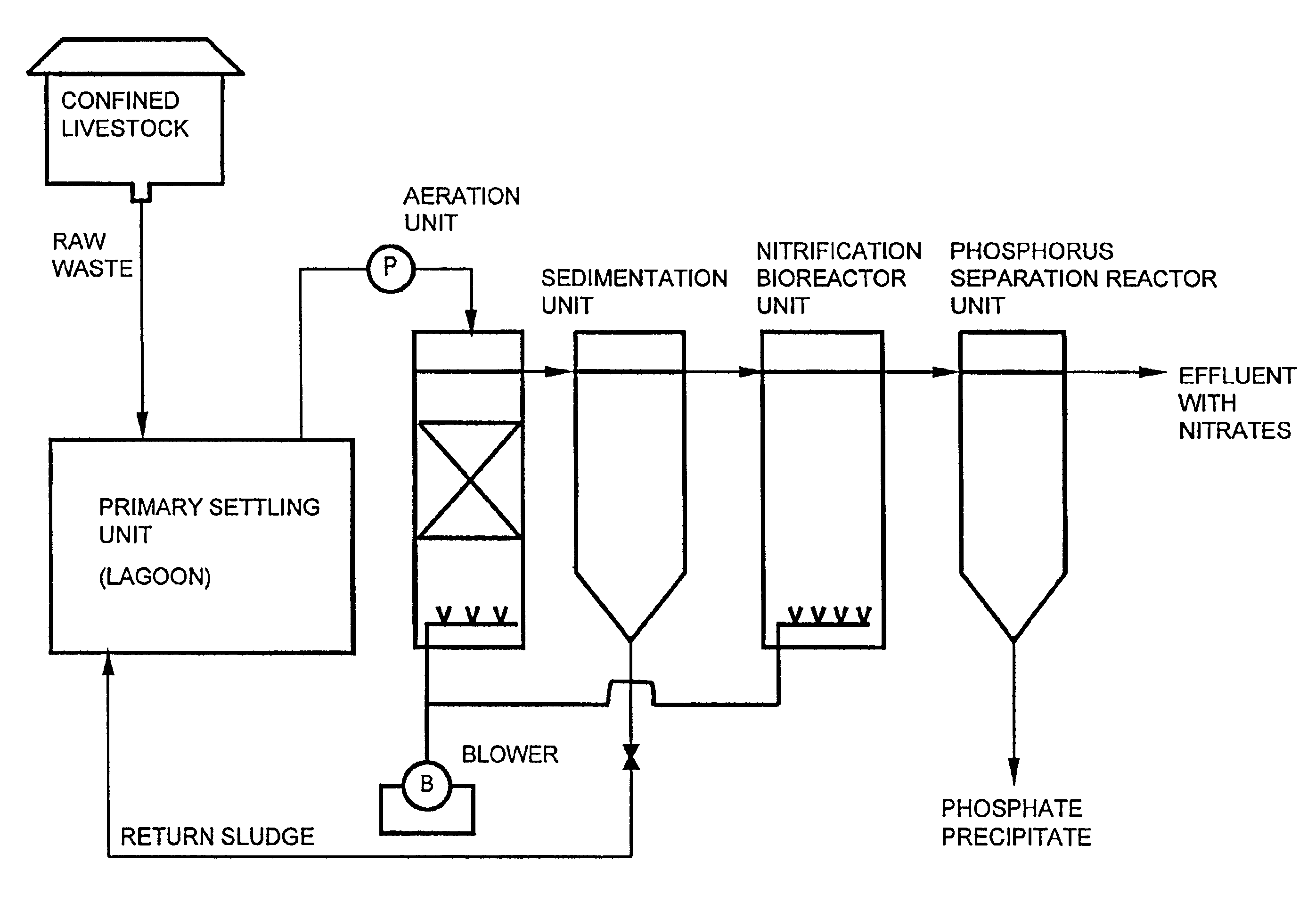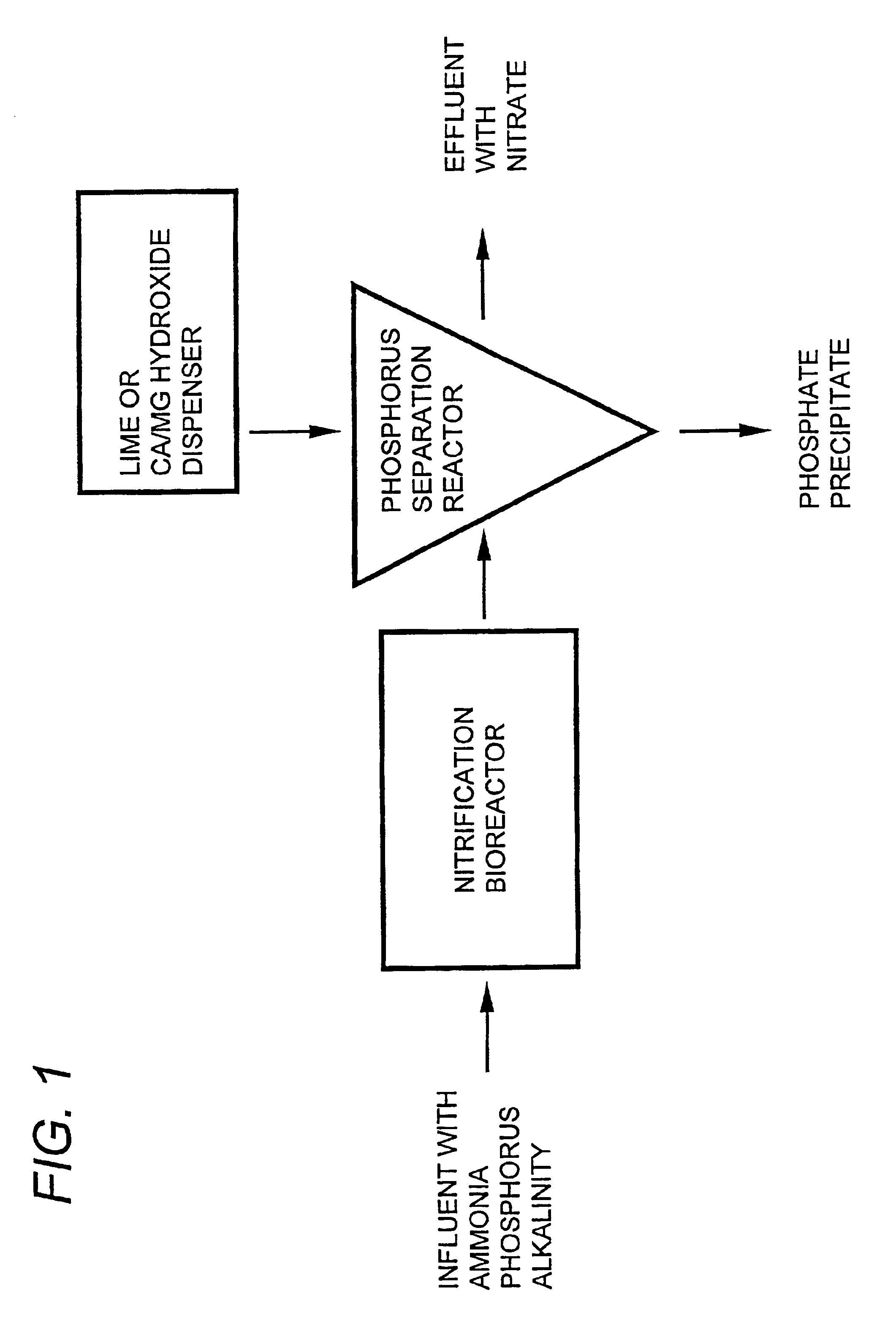Wastewater treatment system
a treatment system and wastewater technology, applied in water/sewage multi-stage treatment, liquid displacement, separation process, etc., can solve the problems of lack of functional and sustainable treatment system, large urban and agricultural waste disposal, and high density of animals
- Summary
- Abstract
- Description
- Claims
- Application Information
AI Technical Summary
Benefits of technology
Problems solved by technology
Method used
Image
Examples
example 1
[0055]Lagoon wastewater from a swine operation was treated in a nitrification vessel during about a 16 hour period. The vessel contained nitrifying bacteria immobilized in pellets made of polyvinyl alcohol (PVA) polymer and aeration that provided oxygen and fluidization of the immobilized pellets (Vanotti and Hunt, 2000; supra; herein incorporated by reference). The nitrifying pellets increased microbial population in the vessel which reduced total treatment time of nitrification. During this nitrification pre-treatment, the natural carbonate alkalinity of about 1880 mg CaCO3 / L of the wastewater was exhausted with a remaining alkalinity of about 63 mg CaCO3 / L in the process of ammonia oxidation (approximately 300 mg nitrogen / L), and the pH decreased from about 7.8 to approximately 6. Even though a pH higher than 9 is needed to optimize precipitation of soluble phosphorus using Ca and Mg based compounds, according to the present invention, the pH of the wastewater is initially lowere...
example 2
[0056]This example demonstrates the use of the above described method to change the N:P ratio of animal wastewater by means of varying calcium addition rates and / or the pH of the reaction. Swine wastewater was nitrified as described above in example 1. It was then transferred to separate laboratory vessels where it was treated with calcium and alkali chemicals to obtain Ca:P molar ratios of about 0, 0.5, 1.0, 2.0, 3.0, 5.0, and 10; and pHs in the range of about 9 to about 12 in one unit increments through addition of CaCl2 and standard NaOH, respectively (See Table 1 below). The rates of calcium applied were calculated based on the initial phosphorus concentration in the wastewater (about 60 mg / L or about 1.937 mmol / L) to establish a range of Ca:P molar ratios resulting in about 285 mg CaCl2 / L applied for each Ca:P molar ratio unit increment. The same pH and Ca treatments were also applied to influent wastewater that was not nitrified (control);for comparison purposes. All experimen...
example 3
[0060]To illustrate that a single compound can be used to elevate pH and at the same time provide the extra Ca or Mg needed to precipitate phosphorus, hydrated lime was used for the chemical addition step. Swine wastewater was nitrified as described above in example 1 to remove ammonia and alkalinity and transferred to a separate laboratory vessel where it was treated with hydrated lime (Ca(OH)2 at a rate of about 151, 753, and 1506 mg / L to obtain Ca:P molar ratios of about 1.0, 5.0, and 10.0 (See FIGS. 8 and 9). The rates of calcium applied were calculated based on the initial orthophosphate concentration in the wastewater (about 63 mg phosphorus / L or about 2.03 mmol phosphorus / L). Identical lime treatments were also applied to the control. The nitrification step was omitted in the control. All experiments were duplicated. Fixed amounts of lime corresponding to each treatment were added to reaction vessels containing either nitrified wastewater or wastewater that had not been nitri...
PUM
| Property | Measurement | Unit |
|---|---|---|
| Acidity | aaaaa | aaaaa |
| Mass | aaaaa | aaaaa |
| Mass | aaaaa | aaaaa |
Abstract
Description
Claims
Application Information
 Login to View More
Login to View More - R&D
- Intellectual Property
- Life Sciences
- Materials
- Tech Scout
- Unparalleled Data Quality
- Higher Quality Content
- 60% Fewer Hallucinations
Browse by: Latest US Patents, China's latest patents, Technical Efficacy Thesaurus, Application Domain, Technology Topic, Popular Technical Reports.
© 2025 PatSnap. All rights reserved.Legal|Privacy policy|Modern Slavery Act Transparency Statement|Sitemap|About US| Contact US: help@patsnap.com



